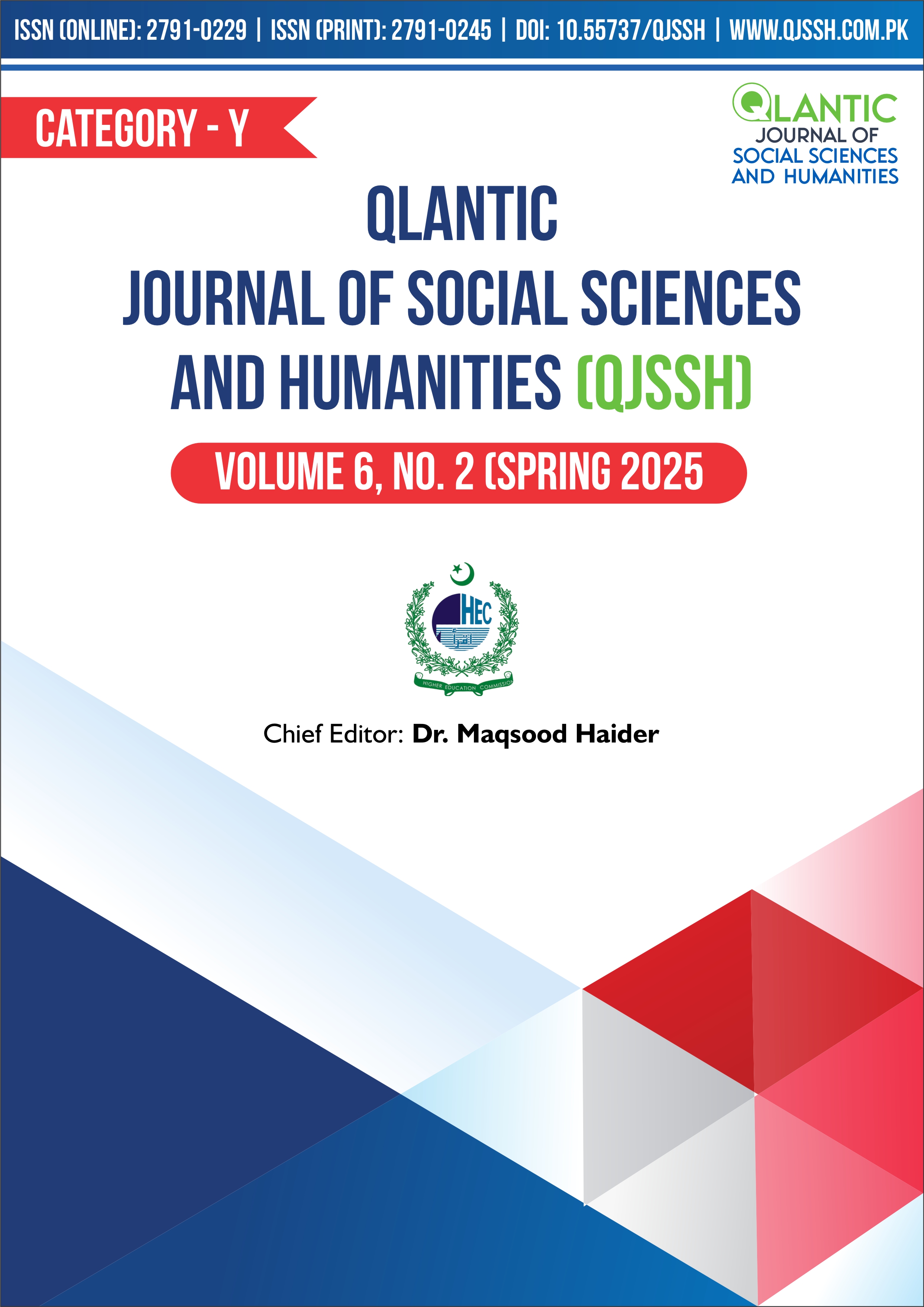Demystifying Patriarchy: A Feminist Study of Shafak's Forty Rules of Love
DOI:
https://doi.org/10.55737/qjssh.vi-ii.25340Keywords:
Oppression, Patriarchy, Feminism, Subjugation, Violence, ProstitutionAbstract
Efforts to get free from oppression often result in gender-based violence. Patriarchy silences women through a range of assumptions and concepts. The present study investigates the role and condition of women in patriarchal systems using Lerner's theoretical underpinnings. To examine the patriarchal systems, the study has been carried out through textual analysis of Shafak's Forty Rules of Love, emphasizing various rituals and events that the author represents. The data of the text have been collected, analyzed, and interpreted through Close Reading. Three female characters, Desert Rose, Kerra, and Ella Robinstein, have been selected from the book and examined in light of societal issues of violence, prostitution, and family. The study finds that the female characters have been viewed as inanimate objects, and their needs are not considered. They are treated inhumanely when they express disdain for patriarchal ideas. It also identifies that patriarchal norms oppress, enslave, and marginalize them.
References
Bhasin, K. (1993). What is patriarchy? Kali for Women.
Bucholtz, M. (2014). The feminist foundations of language, gender, and sexuality research. In S. Ehrlich, M. Miriam, & H. Janet (Eds.), The handbook of language, gender, and sexuality (1st ed.) (pp. 21–47). John Wiley & Sons, Ltd.
Collins, H. (2010). Collins COBUILD advanced learner’s dictionary (V. 10). Collins.
Culler, J. (2011). Literary theory: A very short introduction (2nd ed.). Oxford University Press.
Dickinson, T. D. (Ed.). (2003). Community and the world: Participating in social change. Nova Publishers.
Durrani, T. (1995). My feudal lord. Corgi Books.
Fetterley, J. (1978). The resisting reader: A feminist approach to American fiction. Indiana University Press.
Green, K., & LeBihan, J. (1996). Critical theory and practice: A course book. Routledge.
Hornby, A. S. (2003). Oxford advanced learner’s dictionary. Oxford University Press.
Jagger, M. A., & Rosenberg, S. P. (1984). Feminist frameworks. McGraw-Hill
Legates, M. (2001). In their time: A history of feminism in Western society. Routledge.
Lerner, G. (1986). The creation of patriarchy. Oxford University Press.
Luke, C. (1994). Women in the academy: The politics of speech and silence. British Journal of Sociology of Education, 15(2), 211–230. https://doi.org/10.1080/0142569940150204
Mehmood, S. (2019). Voicing the silences: Women in contemporary Pakistani fiction in English. Pakistan Journal of Gender Studies, 18(1), 113–128. https://doi.org/10.46568/pjgs.v18i1.28
Millet, K. (1977). Sexual Politics. Virago.
Mitchell, J. (1971). Women’s estate. Penguin.
Moi, T. (1985). Sexual/textual politics: Feminist literary theory. Routledge.
Ruthven, K. K. (1984). Feminist literary studies: An introduction. Cambridge University Press.
Shafak, E. (2011). The forty rules of love: A novel of Rumi. Penguin.
Shahzad, K. (2017). Literary theory and criticism. Lahore: Kitab Mahal (Pvt.) Ltd.
Smith, D. E. (1990). The conceptual practices of power: A feminist sociology of knowledge. University of Toronto Press.
Suaidi, S., Rusfandi, R., & Wilujeng, T. T. R. (2016). Feminism reflected in Pride and Prejudice by Jane Austen 1813. Jurnal Ilmiah Bahasa Dan Sastra, 3(1), 85-79. http://ejournal.unikama.ac.id/index.php/JIBS/article/view/1157
Sugihastuti & Itsna, H. S. (2010). Gender & Inferioritas Perempuan, Praktik Kritik Sastra Feminis. Cetakan II (Cetakan I, 2007). Pustaka Pelajar.
Sunderland, J. (2011). Researching language and gender. In B. Paltridge and A. Phakiti, Continuum companion to research methods in applied linguistics (pp. 318-337). Continuum.
Walby, S. 1990. Theorizing patriarchy. Blackwell Publishers Ltd.
Walker, A. (1982). The Color Purple. Phoenix Paperback.
Walker, M. (2005). Feminist methodologies. In Bridget, S. & Cathy, L. (Eds.), Research methods in social sciences. Sage Publications.
Downloads
Published
Issue
Section
License
Copyright (c) 2025 Aneesa Kalsoom, Maryam Munir, Anzala Noor

This work is licensed under a Creative Commons Attribution-NonCommercial 4.0 International License.





